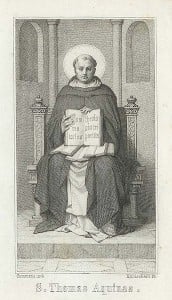 We’re blogging through St. Thomas Aquinas’ Compendium Theologiae, sometimes called his Shorter Summa. Find the previous posts here.
We’re blogging through St. Thomas Aquinas’ Compendium Theologiae, sometimes called his Shorter Summa. Find the previous posts here.
Today’s post is from Chapter 55, “Personal Distinction in God through the Relations”.
Thomas continues his analysis of the Trinity by affirming that the three members of the trinity are persons, and are so precisely because the relations that define them are subsistent.
Since distinction in the Godhead is accounted for by relations that are not accidental but are subsistent, and since among beings subsisting in an intellectual nature personal distinction is discerned, it necessarily follows that personal distinction in God is constituted by the relations in question. Therefore the Father and the Son and the Holy Spirit are three persons, and also three hypostases, since hypostasis means something that is subsistent and complete.
We have run into the term subsistent before: a thing is subsistent if it has its own nature and existence. An apple is a subsistent thing; the apple’s state of ripeness is not, as it does not exist apart from the apple. Thus, by using the term subsistent, Thomas is saying that the Father, Son, and Holy Spirit truly are distinct. St. Patrick famously used the shamrock to describe the Trinity, containing as it does three leaves; but the leaves have their existence only as parts of the whole. The Trinity is truly One in one way and truly Three in another in a way that the shamrock is not.
Next we come to the term person. For Thomas, a “person” is a being having intellect, the power to know, and will, the power to choose. We are persons; angels are persons; God is Three persons.
Finally, we have the term hypostasis. So far as I can tell, hypostasis is simply the Greek equivalent of the Latin word translated here as “substance”. It’s an important word in Christian theology; we usually come across it in the phrase “hypostatic union”, which is the doctrine that Jesus Christ has two natures, human and divine, perfectly joined in one person, one substance, one hypostasis.
____
photo credit: Public Domain; source Wikimedia Commons








